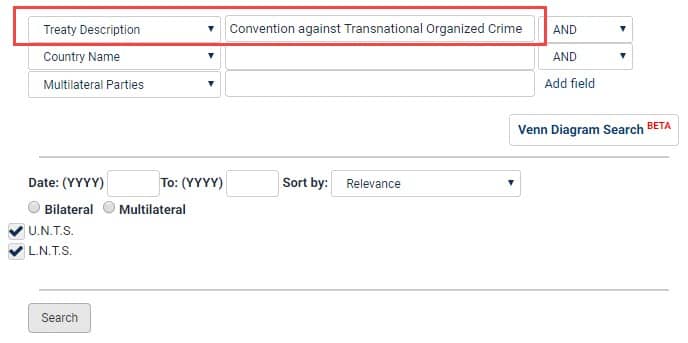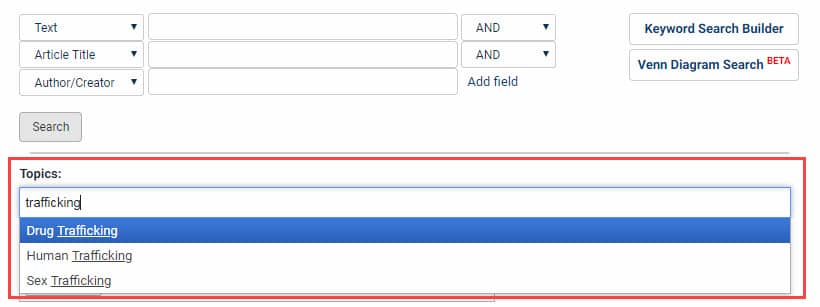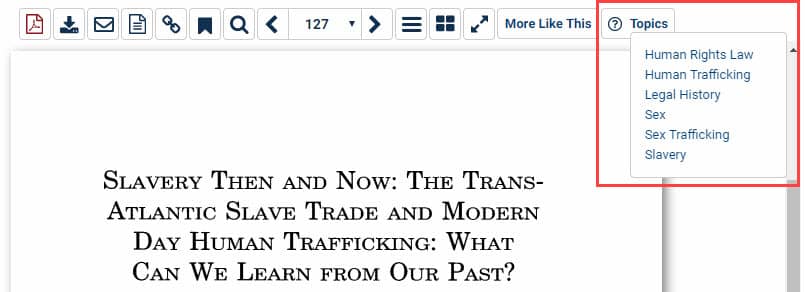Last month, billionaire Jeffrey Epstein was arrested on charges of sex trafficking girls as young as 14. In the same week, singer and record producer R. Kelly was also arrested for sex trafficking, production of child pornography, child sexual exploitation, kidnapping, and forced labor. In both cases, the arrests follow several years of allegations of sexual abuse against minors. As you await the outcome of both trials, study up on the charges by learning more about sex trafficking with HeinOnline.
Before We Get Started
Don’t miss out! Make sure you have the databases we’ll be mentioning in this post. Follow the links below to start a trial today.
What Is Sex Trafficking?
Though often conflated with human smuggling, human trafficking is the procurement of human beings for the purpose of exploitation. Sex trafficking occurs when that exploitation is sexual by nature. The 2000 UN Convention against Transnational Organized Crime (CTOC) defines human trafficking in more depth as:
The recruitment, transportation, transfer, harbouring or receipt of persons, by means of the threat or use of force or other forms of coercion, of abduction, of fraud, of deception, of the abuse of power or of a position of vulnerability or of the giving or receiving of payments or benefits to achieve the consent of a person having control over another person, for the purpose of exploitation. Exploitation shall include, at a minimum, the exploitation of the prostitution of others or other forms of sexual exploitation, forced labour or services, slavery or practices similar to slavery, servitude or the removal of organs… The consent of a victim of trafficking in persons to the intended exploitation set forth [above] shall be irrelevant where any of the means set forth [above] have been used.
Find this treaty in HeinOnline by navigating to the United Nations Law Collection. Select the Treaty Search option hyperlinked in blue under the main search bar. Change one of the drop-down boxes to “Treaty Description” and type in “Convention against Transnational Organized Crime” to view one result.

Sex Trafficking: A Global Issue
Every country in the world is affected by human trafficking, as each has at one point been a country of origin, transit, or destination. Worldwide, an estimated 20-40 million people are currently victims of trafficking, though the full scope of the issue is nearly impossible to determine. It is clear, however, that women and young girls tend to be the most commonly trafficked. Additionally, according to the UN, sexual exploitation is by far the most common form of human trafficking, clocking in at 79% of trafficking cases.
Twentieth Century
Global efforts to combat sex trafficking have been put forth since the early twentieth century. Although little-discussed at the time, the subject became the topic of an international convention in 1901. One of the first multilateral treaties for the prevention of human trafficking, the convention is known as the International Agreement for the Suppression of the White Slave Traffic. In 1921, the newly formed League of Nations sponsored the International Convention for the Suppression of the Traffic in Women and Children, further boosting worldwide recognition of the anti-trafficking movement.
In 1949, the United Nations Convention for the Suppression of the Traffic in Persons and Exploitation of Prostitution of Others became the first international protocol to address sex slavery, acknowledge prostitutes as victims, and use neutral language with regard to gender and race. Parties to the convention are obligated to prohibit trafficking and enact specific anti-trafficking measures at home.
Twenty-First Century
The 1949 Convention paved the way for the 2000 Convention against Transnational Organized Crime. Also known as the Palermo Convention, the treaty outlined the “Protocol to Prevent, Suppress and Punish Trafficking in Persons, especially Women and Children.” With 167 parties, the Trafficking Protocol is currently the only international legal instrument to address human trafficking as a crime. Along with defining the issue, the Trafficking Protocol prohibited the trafficking of persons under 18, suspended parental rights of any caregivers who have trafficked a child, and more.
In 2007, the United Nations began a Global Initiative to Fight Human Trafficking (UN.GIFT) in cooperation with the UN Children’s Fund (UNICEF), the International Labour Organization (ILO), and others. Based on the principle that this issue can not be solved by one country alone, the Global Initiative works with governments, schools, media, businesses, and other stakeholders across the globe to fight human trafficking. To further increase awareness of the issue, the United Nations also established a World Day against Trafficking in Persons in 2013, to be observed on July 30 of each year.
Sex Trafficking in U.S. Federal Law
The United States was ranked in 2018 as one of the worst countries in terms of human trafficking, falling in the top three nations of origin for human trafficking victims. It is further estimated that around 50,000 people are trafficked into the United States each year. In 2018, 51% of active criminal human trafficking cases regarded children.
Twentieth Century
In the early 1900s, Congress focused primarily on the trafficking of white persons. In 1901, the White Slave Traffic Act addressed the rising issue of prostitution and general immorality by punishing those who transported women between states for immoral purposes. As trafficking of foreign, non-white women became more prominent in the early 1920s, Congress turned to immigration legislation like the Emergency Quota Act of 1921 and the Immigration Act of 1924 as preventative measures. (To read more about these immigration acts and others, check out this blog post on the history of United States immigration policy.)
Twenty-First Century
Supplementing Title 18 of the U.S. Code, the Victims of Trafficking and Violence Protection Act (TVPA) of 2000 listed human and sex trafficking as federal crimes for the first time. As the first comprehensive anti-human trafficking law, TVPA covered various types of modern slavery, including involuntary servitude, debt bondage, coercion, and commercial sex acts. Sex trafficking, in particular, is defined in TVPA as “commercial sex acts induced by force, fraud, or coercion, or in which the person induced to perform such act has not attained 18 years of age.” In 2015, President Obama signed an amendment to the act into law to impose a federal fine of $5,000 on traffickers, provide more services to victims, and include human trafficking under the legal definition of child abuse.
In 2018, President Trump signed into law the Stop Enabling Sex Traffickers Act (SESTA) and Allow States and Victims to Fight Online Sex Trafficking Act (FOSTA) as the FOSTA-SESTA package. The two laws help further clarify sex trafficking legislation in the United States, making it a crime to knowingly assist or support sex trafficking. In doing so, the law specifically made websites which had previously facilitated trafficking liable for the actions of their users.
Scholarly Work on Sex Trafficking
To discover scholarly work on sex trafficking and other related topics, head over to HeinOnline’s Law Journal Library. Perform an advanced search by selecting the blue hyperlink under the main search bar. From the advanced search interface, users may search various metadata including related topics. Discover the topics available by entering a relevant subject.

Select a topic and click “Search” to view related articles. Choosing the topic “Sex Trafficking” yields more than 620 relevant results, including:
- Slavery Then and Now: The Trans-Atlantic Slave Trade and Modern Day Human Trafficking: What Can We Learn from Our Past
- Jailing the Johns: The Issue of Demand in Human Sex Trafficking
- Human Sex Trafficking: An International Problem with an International Solution Requiring National Implementation
- Missing the Mark: Why the Trafficking Victims Protection Act Fails to Protect Sex Trafficking Victims in the United States
Click on the first title (Slavery Then and Now). From the article itself, users can utilize the More Like This button to find similar articles or can click on topics to see the other subjects covered in this article. Select any topic to view related search results.

Do you love catching up on current events? Are you more interested in learning about highlights in history? Perhaps you’d rather dive into fun, random subjects like Star Wars, drones, or emojis?
The HeinOnline Blog posts about these topics and more. Hit the Subscribe button to stay in the loop.



